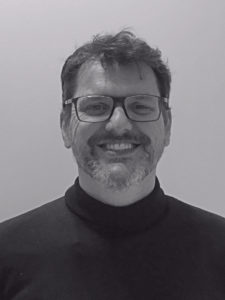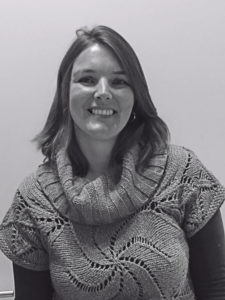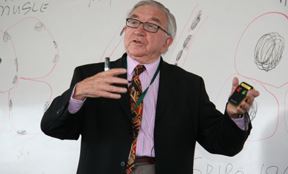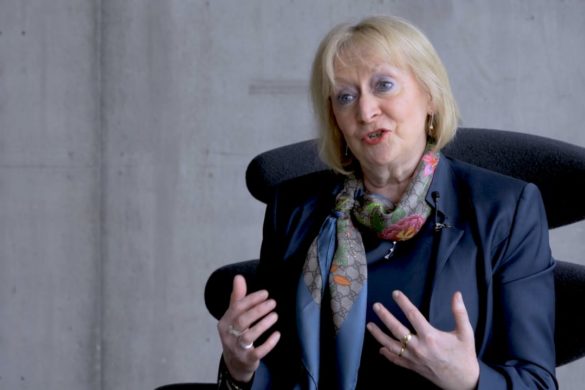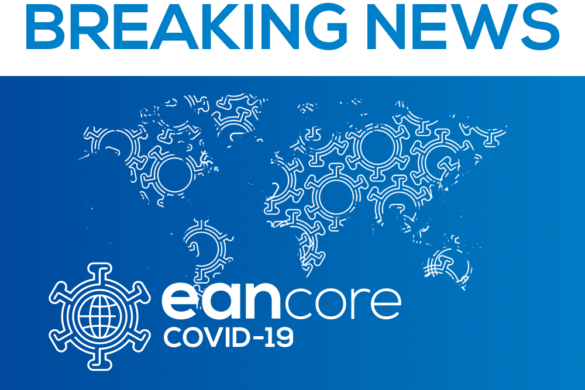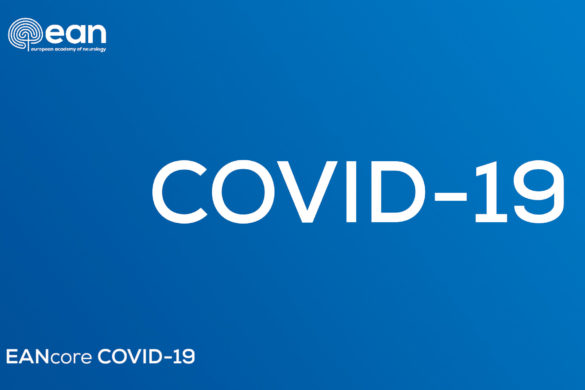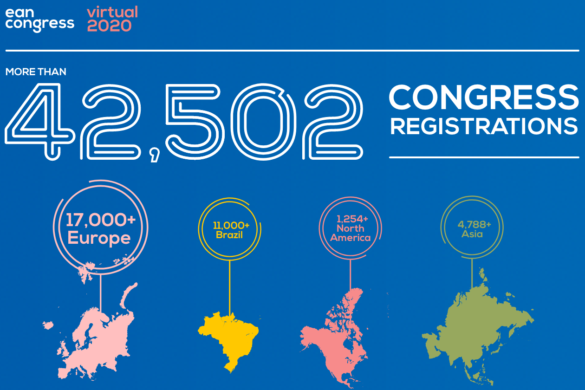Mr. Bertrand Daval – CEO Union Européenne des Médecins Spécialistes
Mrs. Nathalie Paulus – EACCME Coordinator
David B. Vodušek (DBV): UEMS-Union Européenne des Médecins Spécialistes/European Union of Medical Specialists has already a long experience with accreditation of international CME in Europe. Please inform about the situation of CME in European countries. What are the differences between CME and CPD?
Nathalie Paulus (NP): One of the aims of the UEMS has always been to try and harmonise CME/CPD in Europe. In this respect the UEMS regularly conducts surveys in order to explore the state of play of CME/CPD in Europe. The latest survey dates back to 2014. Its results were presented at the second UEMS Conference on CME/CPD in Europe taking place in Brussels on 28th February 2014. 32 countries took part in this survey. From the survey it came out that engaging in CME/CPD activities is becoming increasingly mandatory in most European countries with 19 countries having a mandatory CME/CPD system in place while 13 countries still have a voluntary system. In 27 countries CME/CPD is financed directly by the individual doctor. However other contributors may be the employer, the state body, … or a combination of different types of contributors. Out of the 32 countries sought only 6 do not have a proper CME cycle. For the countries that have a system in place doctors need to collect in average more than 40 credits per year. In most countries CME credits are therefore key to fulfilling national requirements and the European CME credits (ECMEC®s) delivered by the EACCME® are a useful tool to help physicians collect these.
Regarding your second question, the UEMS defines continuing medical education (CME) as educational activities which serve to maintain, develop or increase the knowledge, skills and professional performance and relationships that a physician uses to provide services for patients, the public, or the profession. Therefore all continuing educational activities which assist physicians in carrying out their professional responsibilities more effectively and efficiently are considered as falling into the scope of this definition.
Continuing Professional Development (CPD) is defined as the educative means of updating, developing and enhancing how physicians apply the knowledge, skills and attitudes required in their working lives. CPD rather than CME is the preferred term, as physicians may perform many roles that indirectly affect the quality of healthcare, such as teaching, research and management.
Most of the activities that are accredited by the EACCME® are CME activities but the EACCME® is also receiving more and more applications for events related to CPD rather than CME. This is also one of the reasons why the EACCME® is now offering a new service of recognising CPD/CME activities as I will explain to you later.
Bertrand Daval (BD): To make it brief and simple, I would say that in our domain, CPD is all educational activities preformed by a physician that occur after obtaining the license to practice medicine. CME is just part of it, including Live Educational Events, E-learning materials…
DVB: Please explain the history of EACCME®, its aims, purpose and benefits.
BD: To understand how we came up with this project, it is useful to know who we are. The Union Européenne des Médecins Spécialistes (UEMS) was founded in 1958 with the aim of representing the interests of specialist doctors at an international level. The UEMS is a non-governmental voluntary organisation whose members are the national medical organisations that represent medical specialists in the European Union and in associated countries. In January 2000 the UEMS established the European Accreditation Council for Continuing Medical Education (EACCME®) with the aim of encouraging the highest standards in the development, delivery and harmonisation of continuing medical education (CME) and, later, of continuing professional development (CPD). The purpose of the EACCME® was to provide accreditation of international CME in Europe and to facilitate the recognition of credits between the various countries in Europe. In order to reach this goal, the UEMS-EACCME® signed agreements of cooperation with countries in Europe, and also outside of Europe. In order to support this recognition process the UEMS-EACCME® introduced a common “CME currency”: the European CME Credit (ECMEC®). In 2009, the EACCME® implemented criteria for the accreditation of e-learning materials. In 2016, the EACCME® implemented EACCME® 2.0 including new forms of CME/CPD activities. Nathalie is in charge of this department and I am sure that she will be keen to let you know more about our specificities!
DBV: What is the added value of UEMS-EACCME® accreditation?
NP: All applications submitted to the EACCME® for European accreditation are reviewed according to very high-quality criteria and by medical specialists active in the field. Accreditation by the EACCME® therefore means that the CME/CPD activity provided is of high scientific value, is free of commercial bias and promotes active adult learning. This is of paramount importance to doctors who need to report to their National Accreditation Authority on their CME/CPD activity over a certain period of time, and this even more now that many national systems are (becoming) mandatory and not voluntary. As all EACCME® accredited events are published on the EACCME® platform, doctors can easily find an EACCME® accredited event to attend according to their field of interest. By attending an EACCME® accredited event, they will be able to obtain European CME credits (ECMEC®) which are recognised not only in a majority of European countries (with which the EACCME® has signed agreements), but also in the USA and Canada. By handing in their EACCME® certificate to their National Accreditation Authority, their credits will automatically be recognised and converted into national credits. EACCME® accreditation is widely recognised and attracts many international participants and learners. The EACCME® accredits about 2,000 applications per year.
BD: As you can see it is a massive project which success went beyond our expectations! But we are aware that it must be constantly updated and follow the highest standards.
DBV: There have been recent developments in what EACCME® accredits. Please inform our readers.
NP: In January 2017 the EACCME® implemented the EACCME® 2.0 project. With EACCME® 2.0 the EACCME® has expanded its portfolio of accredited CPD/CME activities. In the field of e-learning, in addition to being able to apply for individual modules, providers now have the possibility to submit an application for an e-platform, an e-library and an app. The EACCME has also implemented new fees for e-learning materials that are more provider-friendly. At the same time the EACCME® introduced the concept of recognition of CPD/CME activities. Let me explain to you what is the difference between accredited and recognised activities. Activities get recognised when the standard pathway of EACCME® accreditation is not followed but the activity has widely recognised educational and/or CPD value and the medical specialist has decided to obtain CPD/CME credits for an activity that has been certified for high quality in a process other than CPD/CME accreditation. Consequently a doctor can receive EACCME® credits for publishing in a peer review journal with an established and recognized editorial process, for performing peer reviews of an article, for lecturing at an EACCME® accredited CPD/CME event and for taking part in a UEMS exam as examiner.
DBV: EACCME® introduced the category of “trusted provider”. Please explain.
NP: Unlike the American and Canadian systems, the EACCME® does not support the concept of accredited provider as it offers no assurance regarding the robustness and fairness of the process when a provider has the right to accredit its own educational activities; it is our belief that this by itself undermines the quality of accreditation. However, the EACCME® recognises the outstanding quality of live educational events organised by a number of providers over many years and trusts that such providers will continue to maintain a record of excellence in CME activities. Therefore, providers with sufficient experience and a satisfactory history of EACCME® applications may apply for the status of Trusted Provider. The Trusted Provider status is about a faster and simpler process, and not about lowering the EACCME® standards and the quality of the accreditation process. The trusted providers will benefit from an expedited process (4 weeks instead of 7 weeks) and will be relieved from providing certain documents (COI disclosure forms) during the submission process but will need to have these available at the time of the event. The Trusted Provider status is granted for a defined period of 3 years.
DBV: There have been and still are some other European agencies which offer accreditation of CME/ CPD. Could you explain why this is so, and why should providers rather choose EACCME®?
NP: Here we have to go back in time. At the end of the 90s the UEMS was approached by a delegation from the American Medical Association (AMA) who was in search of a European partner in the field of accreditation. Since the UEMS represented all European medical specialists and had already produced several policy papers on CME/CPD, the AMA felt that the UEMS was the most appropriate body to start a collaboration with. The AMA presented the US accreditation system to us and the UEMS started developing its own system here in Europe. In order for the system to have a strong basis and to be recognised by all as THE major European accreditation body, the UEMS-EACCME® started signing agreements of collaboration with several National Accreditation Authorities in Europe, the aim of this system being to facilitate the recognition of credits of course. And to date I can confirm that the UEMS-EACCME® is still the only accreditation body in Europe that has this recognition system of credits in place with the competent authorities in each country. The strength of the EACCME® accreditation system also lies in its agreements of mutual recognition of credits with the American Medical Association and the Royal College of Physicians and Surgeons of Canada.
To answer the first part of your question, the other European agencies you are referring to are in fact, for most of them, partners in the EACCME® process. At the UEMS we call them European Specialist Accreditation Boards (ESABs) and these boards are in charge of performing the specialist review of applications on behalf of the UEMS-EACCME®. To go even further in the structure of these Boards, they are in fact a collaboration between a UEMS Specialist Section and the relevant European Scientific Society. I will make a small parenthesis here to explain to you what is a UEMS Section. From the time of its creation the UEMS has established specialist sections for all the specialties listed in the European Doctor’s Directive 2013/55, previously known as Council Directive 93/16. For the purpose of their accreditation activities (and other activities like the European examinations for example) some UEMS Sections have an agreement of collaboration with their respective European Scientific Society, hence the creation of European Specialty Accreditation Boards in the field that concerns us. To come back to your question only the UEMS-EACCME® is entitled to deliver European CME credits (ECMEC®s), the ECMEC® being a trademark of the UEMS.
BD: Nathalie is right in stressing that we gained our legitimacy partly thanks to our agreements with external partners who have valued our expertise and professionalism. Still there are other players because … it is a free world! Competition calls for higher quality and I guess we all share the same aim: ensure the highest standards in education for the highest patient safety possible.
DBV:Do you see a role for the EU Commission in providing guidance in the field of CME and CME accreditation?
BD: We are all well aware of the subsidiarity as guiding principle in organisation of health care services. But professional and patients mobility and differences in healthcare systems call for harmonisation. There both European Commission and UEMS meet in their willingness to pave the way forward in the same direction. In this end the EU Commission issued the Professional Qualifications Directive which is based mostly on training duration and limited number of “common” specialties. The Professional Qualifications Directive states in its article 22 that Member States are required to ensure that professionals update knowledge, skills and competences to maintain safe and effective practice and to keep abreast of professional developments. It also requires in its article 56 from Members states to exchange information and best practice to ‘optimise’ CPD development. The UEMS is 100% in line with this approach and our proposal is to go further and to do more. Nathalie already explained our achievements and projects in the accreditation area. We plea for voluntary harmonisation, for competence-based European Training Requirements for Post-Graduate Training, Common Training Frameworks, European examinations and European Professional Card. I believe that the EU Commission has a major role to play but should not reinvent the wheel. The UEMS has an undisputable expertise and experience in managing CME-CPD assessment. We fiercely defend professional autonomy and self-regulation but the hard work provided on daily basis by our organisation is available to be used by policy-makers to structure in a more visible and efficient way a European CPD model. All players are welcome to build it and we would also need our other partners at EU level. Together with 7 other the European Medical Organisations representing doctors, we made a joint Consensus Statement on CPD in 2015. Briefly, we outlined what we think are key actions and principles: ethical obligation, moderate formalisation, necessary investment of states in CPD, transparency in relation with industry, medical profession as central part of the system etc…
DBV: What are your predictions for the future of CME/CPD and their accreditation in Europe?
NP: The UEMS believes that it has a responsibility to assist in achieving a consensus on the future of the continuing professional development (CPD) of doctors in Europe. It is therefore the UEMS’ aim to further expand its collaboration in Europe with the European Scientific Societies during the course of 2018. As announced at its October meeting with the European Scientific Societies, the UEMS-EACCME® will establish a European Council for CME/CPD which will serve as a forum where the UEMS-EACCME® and the European Scientific Societies will meet to discuss CME/CPD issues and collaboration. The UEMS-EACCME® is also considering embracing other healthcare professionals in its accreditation activities such as nurses, technicians… Now that the EACCME® 2.0 project is up and running the UEMS is already thinking about the future. It has set up various working groups, one of which has the task to prepare the EACCME® 3.0 project. Following the work of this group new forms of recognition of CPD/CME activities will soon be available as EACCME® 3.0 will be submitted for adoption at the next UEMS Council meeting in April 2018.
And last but not least I am pleased to inform you that following the success of previous editions, the UEMS will be holding its fourth conference on CME-CPD in Europe this year which you and your members are most welcome to attend! By the way the UEMS will also be celebrating its 60th anniversary this year!
BD: Indeed! This conference will be taking place on 23-24 November in Brussels at the Crowne Plaza. Thank you for giving us the opportunity to inform more people about who we are and what we do. For those who would like to know, I just can invite them to find us on www.uems.eu (or https://eaccme.uems.eu), or even better, to pay us a visit at the Domus Medica Europaea, rue de l’industrie 24, 1040 Brussels!
Dear Mrs. Paulus, Dear Mr Daval, Thank you for this very enlightening interview and information.
I wish you and UEMS all the best and look forward to further cooperation.
B. Vodusek, Chair EAN Communication Committee

